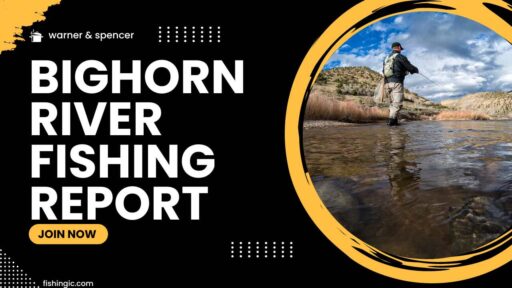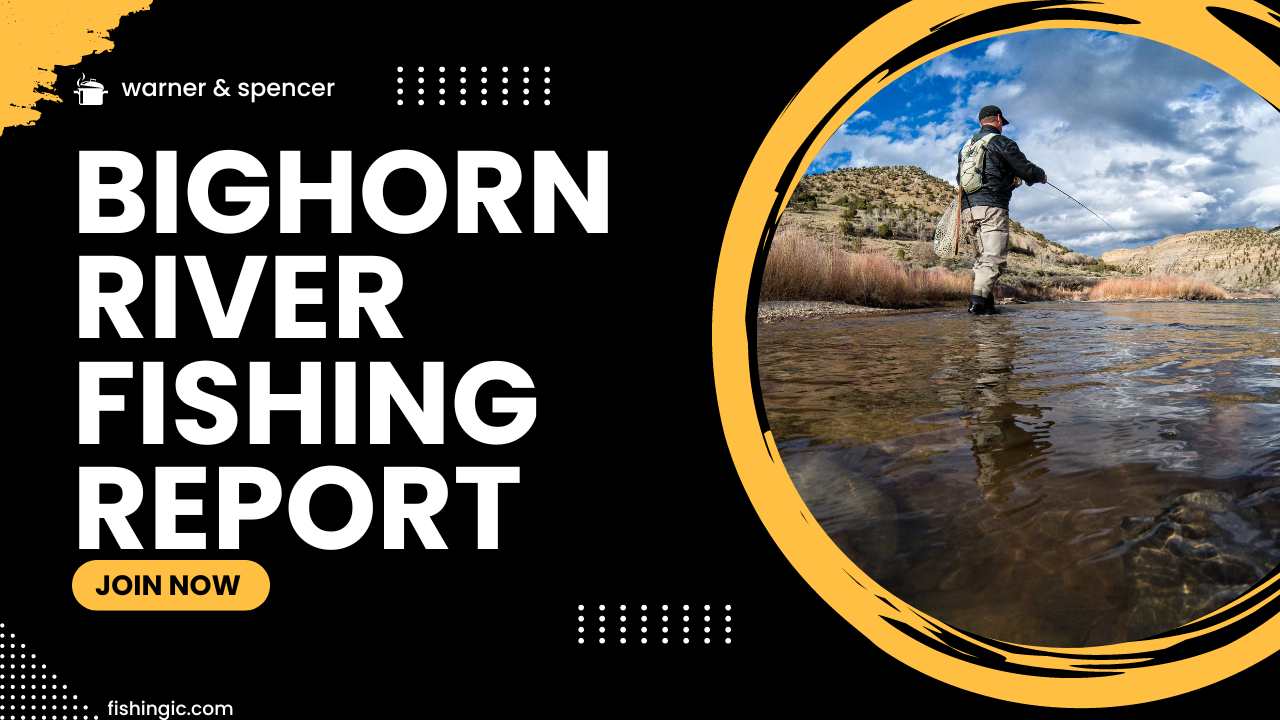Plan your next fishing adventure on the Bighorn River Fishing Report with insights from our detailed fishing report. Stay informed on water conditions, hatches, and more for a successful day on the water.
Introduction to Bighorn River Fishing Report
Roaring with life, the Bighorn River guarantees you a fishing experience that is unforgettable. Before casting your line though, you will need the knowledge provided in this Bighorn River Fishing Report! This extensive review will give you insights on current hatches, water flow, good spots and seasonal changes. Get valuable information and enjoy yourself landing your trophy trout on the famous Bighorn River!.
Importance of Staying Updated with the Fishing Report
Keeping up with the Big Horn River fishing report ensures that your time on these waters is not wasted. Weather patterns, ecological factors, and seasonal changes make the river a versatile ecosystem where conditions are known to change in an instant. This enables one to adjust their strategies accordingly to increase their chances of catching.
The report serves as a helping hand for navigation through the intricacies of its ecosystem. In fact, as hatches occur and water levels fluctuate, different kinds of bait and approaches may prove effective. Without this kind of information, you may be unprepared to use tactics that no longer work. The Bighorn River fishing report means that you are ready for anything while out on the water.
Additionally, it can save time. Reading it before embarking on my trip allows me to take all the necessary gear and choose the best routes. Besides, it spares me some minutes by reducing seconds spent trying various things. As most experienced fishers would agree, time means everything when it comes to angling.
Where to Find The Bighorn River Fishing Report
So where does one find this treasure trove of information? Thanks to local expertise and the internet age; The big horn river fishing report is widely accessible. Online updates are available from numerous fly shops along or adjacent to the bighorn river. Some such reports are even written by individuals who know nearly everything about seasons there as well as species present.
The websites belonging to local fly shops are usually among them. Such stores depend on the success of their clients and thus are more inclined to give reliable information. Likewise, social sites have updated information and discussions about the current state of the river. Anglers also use this platform to share their experience with other users.
On the other hand, for those who prefer personal attention, calling or going to a local fly shop can be very helpful. The workers are usually anglers too, meaning that they are knowledgeable people when it comes to Bighorn River fishing. They may provide extra details that might not be available in an online report.
Understanding The Bighorn River Fishing Report
The Bighorn River fishing report is laden with terms and data which must be comprehended so as to make use of it. The report typically includes some details regarding water flow as well as levels; these aspects are necessary in knowing fish behavior and accessibility of critical areas for angling. Higher flows mean more insects being washed downstream, therefore better feeding condition for fish but also make wading difficult and dangerous.
Another key factor is the temperature of the water, which is essential for trout to survive as they are cold-water species. The presence of these fish can be influenced heavily by the water’s temperature, for example. In determining whether or not fishing will be conducive to active feeding patterns, one should consult the fishing report.
Insect hatches are one of the foundations of fly fishing, and in regards to Bighorn River fishing report, it hardly misses out on giving details on which insects are hatching and at what stage they are. Therefore, understanding how to match your fly with what flies your real current hatch is a great tactic in fly-fishing, and this is clearly stipulated in any given report.
Bighorn River Fishing Conditions
The Bighorn River has many conditions that might affect how well you are able to fish, just like any other natural river. For instance, when there is storm rainfall, it turns muddy, making it difficult for fish to see your bait, while during sunny days- over time, this leads to increased aquatic plant growth, affecting feeding patterns as well as the availability of some species.
Changes that happen with seasons also matter. Fish have their own way of life just like human beings do. In springtime, more hatches occur whereas fall sees them getting ready for winter and becoming more aggressive feeders. You need to know these trends if you want your bait selection and technique to be successful.
Dam releases and agricultural runoff from man-made structures can also alter the river’s condition. Any activities that may influence the behavior of fish or quality of water could be found in different Bighorn River fishing reports.
Utilize Effectively: Tips for Using The Bighorn River Fishing Report
The Bighorn River has much potential for passionate anglers, but before throwing in your line, you have the power of the Bighorn River fishing report. Here are a few tips for increasing your fishing productivity:
Match the Hatch: The current hatch of insects is detailed in the report (juvenile fish food). Use this information to select flies that represent these insects by size, color and movement when tied, thus making them as attractive as possible for trout.
Mind the Flow: Information about the water flow is given in the report. A person might want to use heavier nymphs fished near the bottom during higher flows and lighter dries or streamers during lower river levels.
Location, Location, Location: Based on water conditions and fish activity, there may be productive stretches of the river mentioned in the report. These places should be taken into account while planning a trip.
Seasonal Shifts: Seasonal variations are considered by the report. Reports from early spring could recommend nymphing for pre-spawn fish whereas summer ones may emphasize on dry fly builds for rising trout.
Temper Your Expectations: While fishing reports provide valuable insights they do not have all answers to every question; as weather changes or an unexpected hatch can alter fish behavior.
Combine Knowledge with Experience: However, it is your experience that is priceless on rivers like Bighorn River although a lot of knowledge will be provided through such reports. Use this report to fine-tune already developed strategies and adjust to changing circumstances.
Therefore, by applying these tips you can take advantage of Bighorn River fishing reports turning simple updates into strong aids that can elevate angling skills above average. So prepare your gear let’s see what it has written concerning our beloved Bighorn River!
Best Practices for Understanding The Bighorn River Fishing Report
To interpret the Bighorn River fishing report, one has to understand both biology and have some intuition about how to fish. To begin with, you need to familiarize yourself with the terms which are used in this report. It is important that you start using words like “caddis hatch,” “spinner fall,” or “flow rate” while fishing.
You should review the report against your own experiences and notes from previous trips. This will enable you to know what kinds of conditions work best for you when you are on water. Equally important, do not hesitate to contact author of the report or consultants within your locality who can clarify on any matter that is not clear.
The last thing to do is look at the river as a whole ecosystem. The report may concentrate on specific parts but understanding how these parts interact with each other will give a more comprehensive understanding enabling them make better decisions.
Planning Your Angling Adventure Based on the Fishing Report
Having read through the Bighorn River fishing report, now it is time for you to organize your fishing excursion. Consider such details as peak activity periods, favorite places where fish might be expected, and equipment necessary for angling. So if a particular insect has been hatched in large numbers, as stated in a given fishing report, then flies that match these insects should be put inside someone’s box.
You also have to consider this when planning your trip. In fact, sometimes, within a year, they are better than others, according to historical data and current reports. If possible, be patient enough so that you visit during favorable conditions, unlike forcing it during set dates.
Your competency levels plus preferences should never be left out too. You could reschedule yourself if it happens there are difficult situations proposed such as those exceeding your ability level by waiting or consulting professional guides who offer tutorials about fishing methods.
Other Resources for Staying Updated on the Bighorn River Fishing Conditions
As helpful as it might be, the Bighorn River Fishing Report is not the only resource. You can find other sources of information about the current fishing conditions on this river. There are weather apps and websites that will give you forecasts about changing conditions. A more scientific perspective might also include environmental agency data on water quality and flow rates.
Another option would be social media groups and online forums dedicated to fly fishing in the Bighorn River. Such platforms enable anglers to interact, offering real-time updates besides advising each other of successful experiences encountered while they were catching fish along it.
Finally, consider subscribing to newsletters from local fly shops or conservation groups, where fishing reports are often published together with articles discussing a wider health and ecology system for the river.
FAQs
Let us now look at some common questions people ask regarding The Bighorn River and its fishing report for easy understanding.
How accurate is the Bighorn River fishing report?
The reports compiled by individuals who have first-hand experience of the river tend to be pretty close to the truth. Nonetheless, situations change quite swiftly; therefore verifying with several resources could be worthwhile as well.
Can I fish the Bighorn River year-round?
Absolutely, but changes in condition must be expected during various seasons, for instance, if it’s hot or cold. Visiting times recommended by a fishing report may help you plan your dates.
Do I have to get a fishing license to fish in the Bighorn River?
A Montana fishing license is required to fish in the Bighorn River. Please ensure that you acquire one before your trip and familiarize yourself with any specific rules applying to that river.
Conclusion: Why the Value of Big Horn Bighorn River Fishing Report is Essential for a Successful Fishing Trip
A Big Horn Bighorn River Fishing Report is an essential document for every angler who wants to experience the adventure of catching fish in this beautiful waterway. Providing us with enough information about the state of the river gives us power over the decisions we make and the tactics we apply depending on our setting. Through being current with its last publication; by treating its ecological diversity as sacred grounds and embracing friends when available, an outing can become successful while still ensuring sustainability in this favorite sport.
Above all else, remember that the Bighorn River Fishing Report is not just a place where people go fishing—it’s also an opportunity to enjoy nature, test oneself, and engage in a centuries-old tradition. With these thoughts in mind, let the Bighorn River fishing report direct you towards an exciting day out on the water next time you go angling again.





